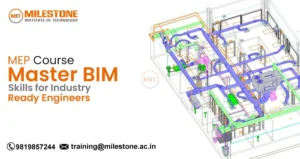In this developing world of architecture, engineering and construction, BIM has transformed the AEC industry drastically over the past years by enhancing the accuracy and efficiency of building design and management. The demand for experts with BIM expertise is only going to grow as technology develops. In 2024 and beyond, learning BIM is becoming more crucial than ever for industry professionals as well as engineers. In this blog, we will be exploring the top 10 benefits of
learning BIM and why it is a valuable investment into your career.
What is BIM?
BIM—
Building Information Modelling is a digital representation of physical and functional characteristics of places. This process includes building a 3D model that combines all areas of a construction project, such as architectural plan design, structural engineering, mechanical systems and many more. It is a technique used for building design and construction, it works in a collaborative nature where all can work from one model. This integration increases collaboration, decreases mistakes and assists with making professional decisions during the project life cycle.
Why BIM Matters in the AEC Industry
BIM has changed the way people think about managing building projects and has redefined the AEC industry. As opposed to traditional 2D drawings and paper-based documentation, BIM is three-dimensional and can provide a model that changes and updates in real-time. This change has surprising consequences on the way the projects are designed, executed and managed:
- Enhanced Collaboration: By offering a centralized platform for all project information, BIM promotes improved cooperation between architects, engineers, contractors, and clients.
- Improved Accuracy: The detailed and precise nature of BIM models reduces the likelihood of errors and discrepancies, leading to higher-quality outcomes.
- Efficient Project Management: BIM streamlines project management processes, making it easier to track progress, manage resources, and meet deadlines.
- Cost Savings: BIM helps save expensive revisions and rework during construction by seeing any problems early in the design process.
Top 10 Benefits of Learning BIM for Engineers
1. Enhanced Design Accuracy
Engineers can produce extremely precise designs because of BIM’s extensive modeling capabilities. This precision reduces the likelihood of errors during construction, leading to fewer costly revisions and rework. Engineers can visualize and analyze every aspect of a project before it is built, ensuring that design specifications are met and potential issues are identified early.
2. Improved Collaboration
BIM promotes a collaborative approach by allowing multiple stakeholders to work on the same model simultaneously. This integrated environment ensures that architects, engineers, contractors, and clients are all on the same page, which fosters better communication and coordination. Projects can thus proceed more easily and effectively.
3. Efficient Project Management
Learning BIM tools provide powerful project management capabilities, including scheduling, budgeting, and resource allocation. By integrating these aspects into the BIM model, engineers can manage timelines and costs more effectively, identify potential delays, and optimize resource use. Increased client satisfaction and better project outcomes are the results of this comprehensive strategy.
4. Advanced Visualization
Engineers can produce extremely precise designs because to BIM’s wide modeling capabilities. These visual representations help stakeholders understand complex projects more easily and make informed decisions. High-quality visualizations can also be used for client presentations, marketing, and stakeholder engagement, enhancing the overall project experience.
5. Better Conflict Detection
BIM models facilitate advanced clash detection, which helps identify and resolve conflicts between different building systems before construction begins. By detecting and addressing these issues early, engineers can avoid costly and time-consuming problems on-site, leading to smoother project execution.
6. Enhanced Sustainability
By examining and improving the performance of buildings, Engineers may encourage sustainable design methods with the use of BIM. Through energy modeling and simulation, engineers can assess the environmental impact of their designs and make informed decisions to improve energy efficiency, reduce carbon footprints, and achieve sustainability goals.
7. Streamlined Documentation
The creation of construction documents, such as sections, elevations, and plans, is automated by BIM. This automation reduces the time and effort required to produce accurate documentation and ensures that all documents are consistent with the BIM model. This efficiency is particularly beneficial for large-scale projects with extensive documentation requirements.
8. Improved Facility Management
BIM is used in facility management in addition to design and construction. Throughout the building’s lifetime, the model is an invaluable tool for operations and maintenance. Facility managers can access up-to-date information about building systems, components, and maintenance schedules, leading to more efficient operations and reduced lifecycle costs.
9. Competitive Advantage
Proficiency in Learning BIM gives engineers a competitive edge in the job market. As the AEC industry continues to adopt BIM technologies, employers increasingly seek professionals who are skilled in these tools. By learning BIM, engineers enhance their employability, career prospects, and potential for advancement within their organizations.
10. Future-Proof Skills
Learning BIM equips engineers with skills that are essential for the future of the AEC industry. As technology continues to evolve, BIM will remain a fundamental tool for designing and managing complex projects. By staying current with BIM practices and technologies, engineers ensure that their skills remain relevant and adaptable to future developments in the industry.
Career Opportunities after Learning BIM
Learning BIM can significantly expand your career opportunities within the AEC industry. Engineers with BIM expertise are well-positioned for roles such as BIM Manager, BIM Coordinator, Project Manager, and Design Engineer. Additionally, BIM skills are valuable in specialized areas like sustainability consulting, facilities management, and construction technology. The need for qualified BIM specialists is predicted to increase as the sector embraces digital transformation more fully, providing potential for career growth and promotion.
Where to Learn BIM?
For those interested in learning BIM, the Milestone Institute of Technology offers comprehensive
BIM courses designed to equip you with the skills and knowledge needed for a successful career. The institute provides hands-on training, expert instruction, and a robust curriculum that covers various BIM software and techniques. With its focus on practical application and real-world scenarios, Milestone Institute of Technology is an excellent choice for anyone looking to advance their BIM expertise and career.
Frequently Asked Questions
What is the major difference between traditional CAD vs BIM?
BIM involves creating a detailed, multi-dimensional model of a building, incorporating data and real-time updates. Traditional CAD (Computer-Aided Design) typically focuses on
2D drawings and static representations, lacking the integrated data and collaborative features of BIM.
How long does it take for learning BIM?
The level of the course and your past expertise will determine how long it takes you to learning BIM. Generally, a comprehensive BIM course can range from a few weeks to several months. Learning may be improved through intensive courses and hands-on training.
Are BIM skills applicable to all engineering disciplines?
Yes, BIM skills are useful in many different types of engineering fields of expertise, such as structural, mechanical, electrical, and civil engineering. BIM’s collaborative and integrative approach benefits all areas of engineering by improving design accuracy and project coordination.




